W & W RR Shed
Introduction
Text-to-speech Audio
The W&W Shop houses the Second No. 4, a locomotive that was in service between 1916 and 1933 on the Waynesburg & Washington Railroad. The Waynesburg & Washington was a 28-mile narrow-gauge railroad that connected Waynesburg, PA and Washington, PA. The Pennsylvania Railroad indefinitely loaned the locomotive to the Greene County Historical Society in 1958 and it has been on display here since 1974. Also housed in the W&W Shop is W&W Passenger Coach No. 6, currently under restoration by GCHS volunteers.
Images
W & W RR building


One side of the Second No. 4 is painted with the W&W RR No. 4 branding.
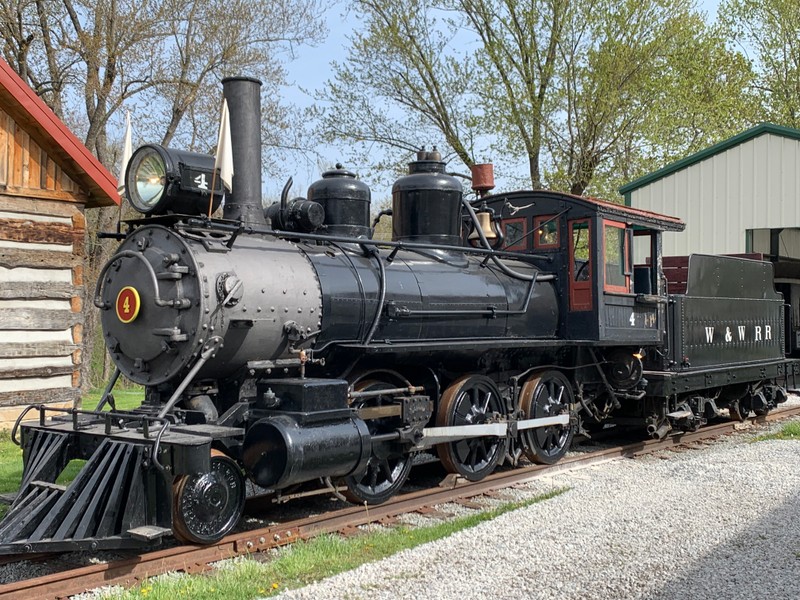
The Second No. 4 at the Opening Day event, April 2022.

Author and volunteer Jim Weinschenker with the Second No. 4 at Opening Day, April 2022.

The other side of the locomotive is painted with the Pennsylvania No. 9684 branding.
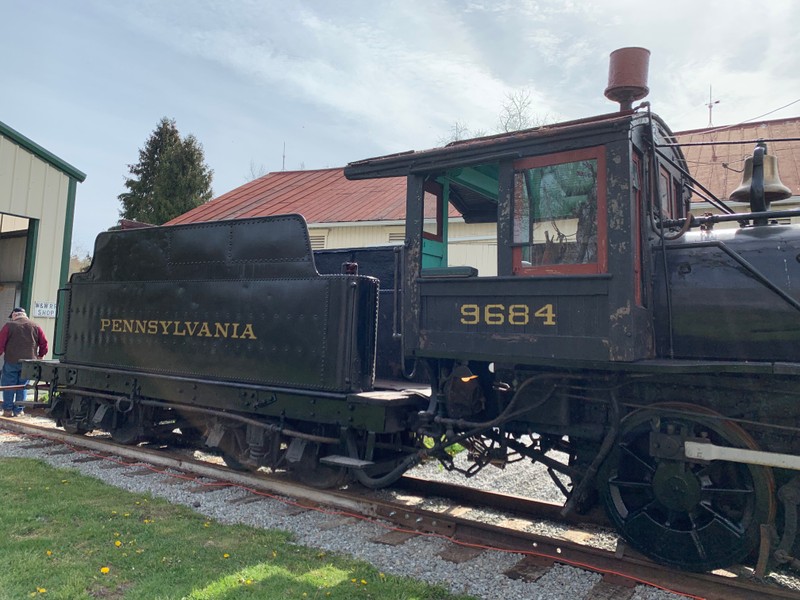
Volunteers work on the locomotive during Opening Day, April 2022.




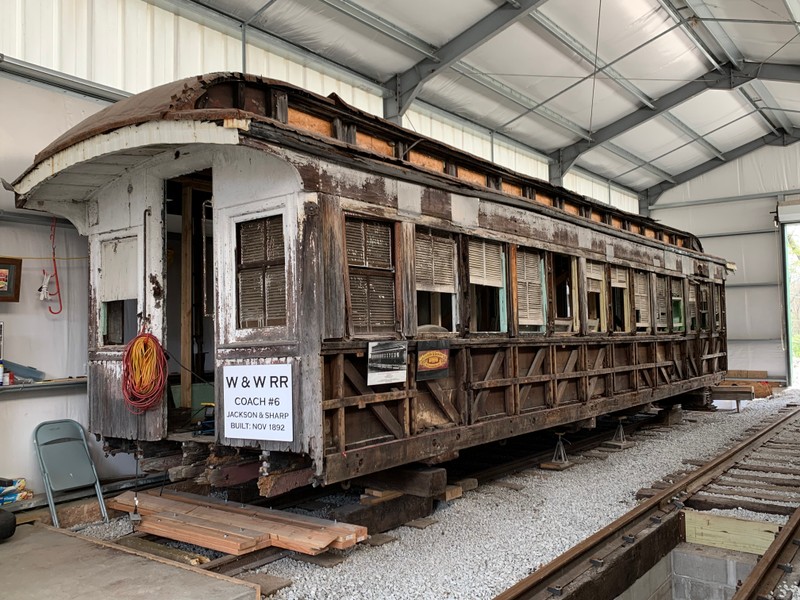

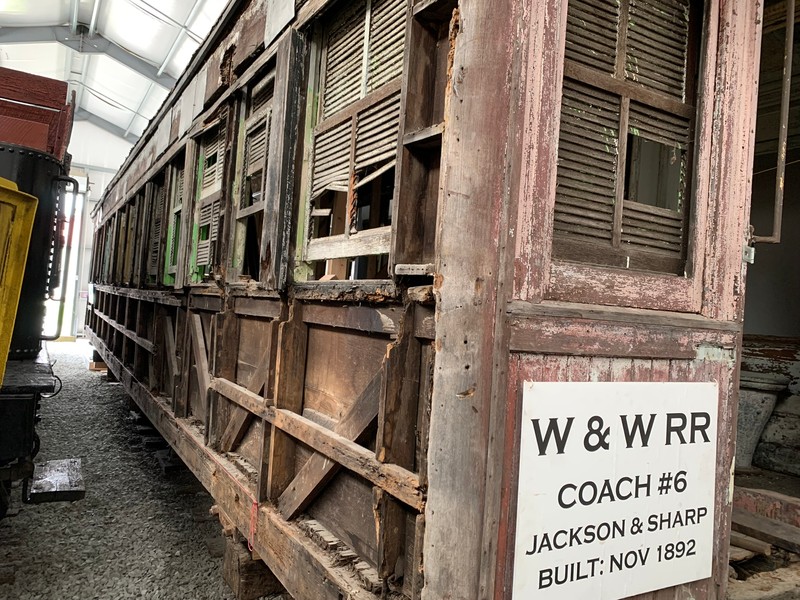
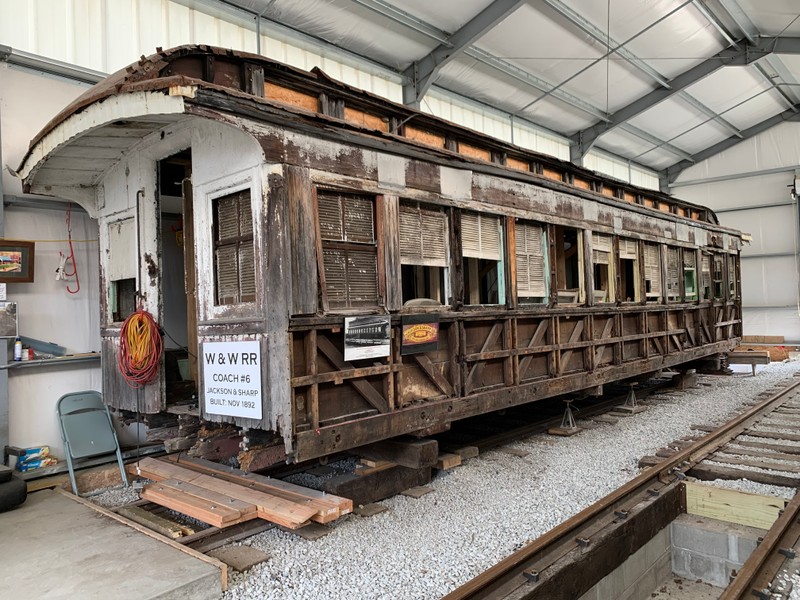
Backstory and Context
Text-to-speech Audio
The Waynesburg & Washington Railroad
The Waynesburg & Washington Railroad (W&W RR) began operation in 1876 and connected Waynesburg, PA and Washington, PA (the county seats of Greene and Washington counties). The W&W RR then interchanged with the Pennsylvania Railroad (PRR) at Washington. A total of 12 locomotives were used during the history of the W&W RR. The W&W line was 28 miles long and within that 28 miles there were 178 curves, 32 bridges, 11 major stations (staffed by agents), and a couple of flag stops. The W&W carried both passenger and freight services. The Waynesburg & Washington ran independently until 1885 when the Pennsylvania Railroad purchased the line. It continued to operate under the W&W RR name until 1921 when the PRR reorganized and relabeled all equipment with “Pennsylvania.”
The W&W RR was a narrow-gauge railroad, with a three-foot gauge. This was relatively common in railroad lines laid in the 1870s and 1880s. By the end of the 1800s there was a standard gauge adopted along all railroad lines to facilitate smoother transportation over longer distances (instead of having to stop and switch trains with each new gauge, all trains could travel over the standard gauge). The W&W, however, was not regauged to the standard gauge during its main period of service, even after the Pennsylvania Railroad acquired the line. The line was converted to standard gauge in 1943-1944, but it did not operate as a revenue service at this point.
The last W&W passenger service was on July 9, 1929 and freight service ended April 6, 1933.
Why is this Locomotive Called Second No.4?
The First Number 4 was the W&W RR’s first Mogul type locomotive, delivered in 1889. First No. 4 was in service for about 27 years until it began to show its age. In 1916 the W&W RR contracted the American Locomotive Company to build a replacement locomotive. The new locomotive was constructed at Cooke Works in Patterson, NJ as construction number 55847 and this was the engine called Second No. 4. Second No. 4 was delivered to the W&W RR in May 1916 and went into freight service June 17, 1916.
Second No. 4—Mogul-Type Locomotive
The Waynesburg & Washington Railroad initially used 4-4-0 locomotives prior to 1901. This numbering system (known as the Whyte notation) refers to the leading wheels—driving wheels—and trailing wheels. The 4-4-0 locomotives were not heavy enough to efficiently provide traction to haul freight on the W&W route, so the company looked to move to a different engine. A 4-6-0 locomotive would have been heavy enough to haul freight, but not able to maneuver through the sharp curves located on the route.
The W&W RR chose the 2-6-0 Mogul locomotive and exclusively used this type after 1901. The 2-6-0 configuration was heavy enough to give the power needed to get up the steep grades and haul freight. To manage the sharp curvatures of the route the Moguls had one “blinded” driver, typically the middle of the three drivers. A “blinded” driver does not have the usual flange on the inside of the wheel—this allows the rigid wheelbase to navigate sharper curves compared to a wheelbase with all flanged wheels.
The 8 W&W Moguls had 42” drivers with the middle driver “blinded, 13” x 20” cylinders, and weighed 49,000 to 51,150 pounds. The Second No. 4’s basic design was a narrow gauge 2-6-0, with slide valves and Stephenson link valve gear, and a wooden cab (which was unusual at that point since most locomotives were built with steel cabs).
After 1920 the locomotives were electrified with a generator behind the smokestack and headlights. The locomotives were also renumbered at this time. The W&W locomotives were the 968X series with X being the W&W roster number. The Second No. 4 was numbered 9684.
History of the Second Number 4 After Service
The Second No. 4 was in active service until April 6, 1933 when W&W freight service ended. At the end of that month the locomotive was transferred to the Pennsylvania Railroad and placed in storage at the PRR Canton, OH shops. It remained there between 1933 and 1953, although it was placed on display briefly in August 1936 for the Wheeling, WV Centennial. In January 1953 Second No. 4 was transferred to the PRR shops at Northumberland, PA for storage.
In January 1958 Gordon Wood, then Vice President of the Greene County Historical Society, wrote to the Pennsylvania Railroad agent at Waynesburg, William A. Patterson. Wood asked that the Second No. 4 be returned to Greene County and put on display. Morton S. Smith, the PRR Vice President, agreed to indefinitely loan the locomotive to the historical society with no cost to the railroad except the initial transportation to the display location. In July 1958 Second No. 4 was transferred to the PRR shops at Juniata for restoration before its presentation to the Greene County Historical Society.
The Second No. 4 was originally displayed at the Greene County Fairgrounds and about 60 feet of narrow-gauge track was laid in preparation for the locomotive’s arrival. The locomotive arrived on August 8, 1958, just in time for the Greene County Fair. Morton S. Smith formally presented Second No. 4 to the Greene County Historical Society in a dedication ceremony on August 14, 1958. Symbolically, Morton presented the document of agreement to James W. Swart, the oldest living W&W engineer. Swart was the engineer who ran the last passenger run of the W&W on July 9, 1929 and he wore his old engineer hat, gloves, and handkerchief at the ceremony. Swart then presented the document of agreement to Albert Moredock, then president of the Greene County Historical Society, and his gloves and hat to David Gordon Wood (grandson of Gordon Wood).
Second No. 4 was on display at the Greene County Fairgrounds between 1958 and 1974. In 1974 the county planned for a new 4-H building at the Fairgrounds and the locomotive needed to be moved. Since the Greene County Historical Society then had acquired its permanent home at the Greene County Poor Farm, it could take custody of the locomotive. Greene County authorized $1000 to move the locomotive, track, and the covering shed to the historical society property and William S. Hopkins and Sons won the bid. Second No. 4 was moved from the Fairgrounds to the historical society grounds on June 6, 1974. When the locomotive arrived it was in poor condition from being displayed outdoors for many years.
In 1977-1978 Tim Sposato, Brad Lester, and a crew of volunteers undertook a restoration of Second No. 4 to bring it back to operation. They successfully made the locomotive operational, although some parts proved difficult to fully repair or replace. Between 1978 and 1985 Second No. 4 steamed over the 100 feet of track laid before and after its cover shed, largely during the annual Harvest Festivals. After 1985 Sposato and Lester moved on to different things and Sposato removed several appliances from the locomotive (such as the number plate, whistle, bell, gauges, headlight, and other operational features) to protect them from vandalism and prevent untrained staff from attempting to operate the locomotive. After Sposato and Lester left, Second No. 4 was only brought out for static display during Harvest Festivals and was no longer operated under steam. The engine was largely moved out of its covering shed by tow truck and its condition again worsened due to exposure to the elements.
In 1999-2000 a new team of volunteers, including Jim Weinschenker who authored a book on the Second No. 4, completed a cosmetic restoration of the locomotive. Unfortunately many of the original appliances that had been removed from the locomotive in 1985 and put into storage were found to be missing. The original bell and one of the original gauges were found and reinstalled but the original whistle, number plate, and several other pieces are gone. Reproductions were made and installed in their place. As the engine was no longer in operational condition, the team decided to restore one of the historical society’s two Plymouth locomotives to working condition in 2001 to move the larger Second No. 4. The two smaller locomotives were purchased in April 1985 from Dave Hamely to provide power to the Second No. 4. The operational Plymouth is a 1950, 7-ton, Model DLHT and the second. The second Plymouth was a 1924, 7-ton, Model DL and the historical society donated it to the American Industrial Mining Company Museum in Ohio.
Recently volunteers completed additional cosmetic restoration work and re-laid the stretch of track that the Second No. 4 moves on.
W&W Passenger Coach 6
Passenger Coach No. 6 is a wooden passenger coach constructed by Jackson & Sharp Company in November 1892 for a cost of $2,375. The coach is 40’ 9” over endbeams and the body is 35’ 2” by 8’ 3”, weighs 26,400 pounds, and has 24-inch wheels. Originally furnished, the interior had 44 plush walkover seats, stoves, a toilet, two-burner Adams and Westlake chandeliers, three-ply oak veneered headlinings, and 13 windows per side with blinds. W&W Coach 6 ran in the last Waynesburg & Washington passenger service on July 9, 1929.
After the W&W RR ended passenger service in 1929 most of the passenger equipment was sold or scrapped, but Coach 6 survived and was sold to the Attapulgus Clay Company of Georgia. The Attapulgus Clay Co. used Coach 6 for miner transportation until the 1930s when the company switched over to using trucks. While the company sold off most of its locomotives and rolling stock, they kept Coach 6 and used it for a time as the company’s mining office. Coach No. 6 was then used as the Attapulgus United Steel Workers union hall until sometime in the 1950s when it was sold to a private owner. The coach was in private hands between the 1950s and 1985. During this time the owner stripped most of the seats and accessories out and converted it to a home with tin siding over the exterior.
In 1985, after Greene County Historical Society volunteers had undertaken the restoration of Second No. 4, they were searching for rolling stock to display with the locomotive. They located the Coach No. 6 in Georgia and purchased it for $500 from the Englehard Corporation, the parent company of the Attapulgus Clay Company. The coach was transported by truck from Georgia to Waynesburg, PA and placed on blocks next to the narrow gauge rail at the historical society. Volunteers planned to restore Coach No. 6 to run behind locomotive Second No. 4 which had just been restored to operating condition.
Unfortunately, fundraising fell short and the restoration project did not progress very far. By the mid-1990s the historical society decided to burn the coach as its condition had deteriorated. Fortunately, Bob Hungerford of the Connecticut Antique Machinery Association inquired about Coach No. 6 before it was demolished, and the CAMA purchased the coach on December 7, 1996 with the intent to restore the coach to operation. CAMA began restoration work and installed some new structural elements between 1996 and the early 2000s, but this restoration project also was never completed and instead the coach was used as a storage unit.
In 2014, Coach No. 6 was advertised for sale by CAMA and author Jim Weinschenker inquired about returning the coach back to the Greene County Historical Society. CAMA agreed to donate the coach back to the GCHS and Coach No. 6 was transported from Kent, CT to Waynesburg, PA in August 2015. Currently Jim Weinschenker and a team of GCHS volunteers are working to restore Coach #6 to operating condition.
The W&W Building
The original housing for Second No. 4 at both the Greene County Fairgrounds and the Greene County Historical Society was an open-sided shed. This provided only a roof for protection, which exposed the locomotive to the elements for many years. This original shed was transferred from the Fairgrounds to the current shed location when the locomotive was transferred in 1974. Eventually the historical society enclosed the sides of the shed to try to reduce the impact of the elements on the locomotive, with a cover on the front during the winter. While helpful, the semi-enclosed shed turned into a wind tunnel which continually deposited dirt and debris on the locomotive.
In 2010 a committee discussed options for a better housing shed for Second No. 4 and they acquired a grant from the Commonwealth of Pennsylvania. The historical society demolished the original shed and constructed the current steel shed that has rollup doors at each end to allow the locomotive to move in and out but also close tight against the weather.
Sources
Email between Jim Weinschenker and Kathleen Thompson, April 28, 2022.
"W&W RR Coach 6." PowerPoint presentation, provided by Jim Weinschenker.
“W&W Railroad History.” Greene County Museum. Accessed April 27, 2022. https://greenecountyhistory.org/ww-railroad-history/.
“W&W Second Locomotive #4.” Greene County Museum. Accessed April 27, 2022. https://greenecountyhistory.org/ww-second-locomotive-4/.
Weinschenker, James D. Waynesburg & Washington Railroad Second Number 4. Waynesburg, PA: Rhodes and Hammers Printing, 2014.
Photograph by Kathleen Thompson, April 2022
Photograph by Kathleen Thompson, April 2022
Photograph by Kathleen Thompson, April 2022
Photograph by Kathleen Thompson, April 2022
Photograph by Kathleen Thompson, April 2022
Photograph by Kathleen Thompson, April 2022
Photograph by Kathleen Thompson, April 2022
Photograph by Kathleen Thompson, April 2022
Photograph by Kathleen Thompson, April 2022
Photograph by Kathleen Thompson, April 2022
Photograph by Kathleen Thompson, April 2022
Photograph by Kathleen Thompson, April 2022
Photograph by Kathleen Thompson, April 2022
Photograph by Kathleen Thompson, April 2022
